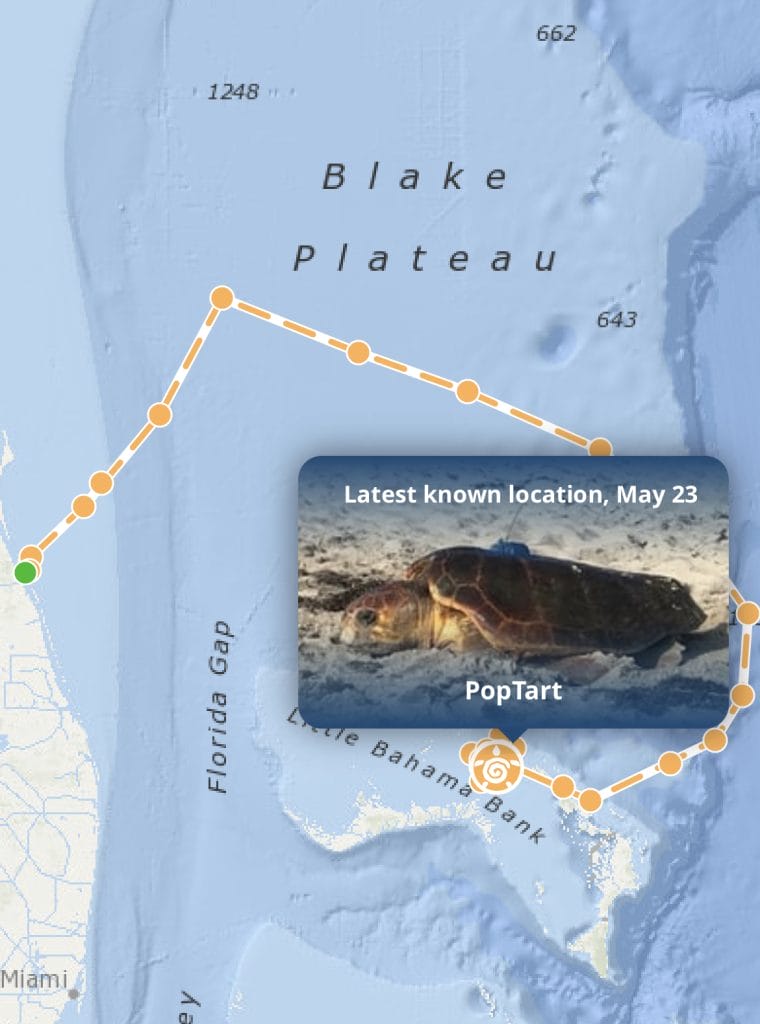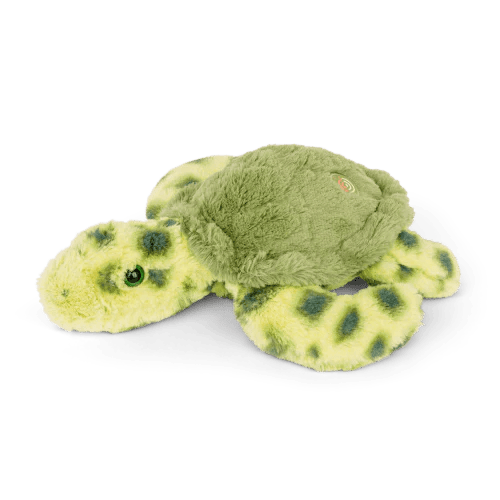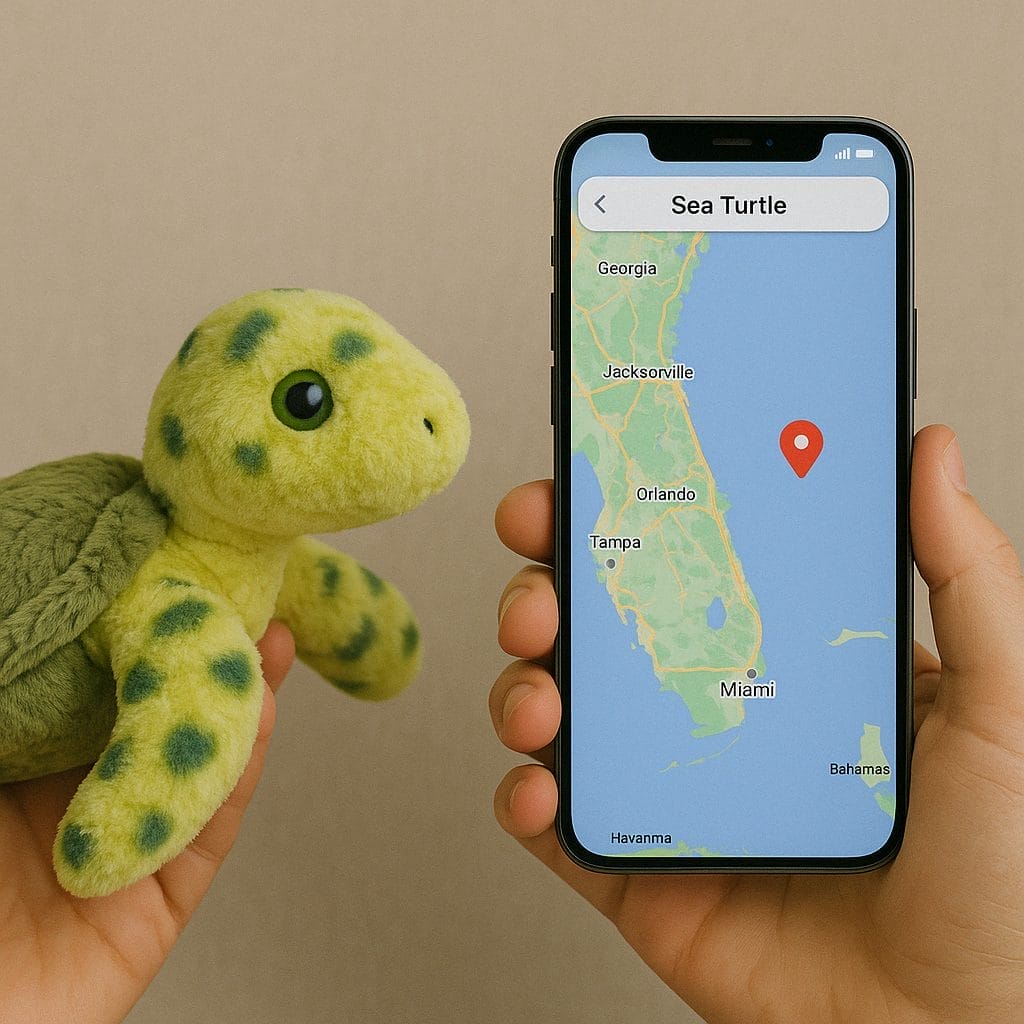Sea Turtle Identification Guide: 7 Species Comparison [With Photos]

This post was created with help from AI tools and carefully reviewed by a human (Muntaseer Rahman). For more on how we use AI on this site, check out our Editorial Policy.
There are 7 species of sea turtles worldwide, each with distinct features that make identification easier once you know what to look for.
The quickest way to identify a sea turtle is by checking three things: shell shape, number of scutes (shell plates), and head size.
Below, you’ll find a comparison chart followed by detailed identification guides for each species with photos.
Quick ID Cheat Sheet
- See overlapping scutes? → Hawksbill (only species with this)
- No hard shell at all? → Leatherback (soft, leathery with 7 ridges)
- Massive head? → Loggerhead (head is disproportionately huge)
- Only in Australia? → Flatback (found nowhere else)
- 6-9 scutes per side? → Olive Ridley (most scutes of any species)
- Round + smallest? → Kemp’s Ridley (most endangered, ~2 feet)
- 4 scutes + blunt beak? → Green sea turtle (most common near reefs)

| Sea Turtle | Shell Shape | Scutes (Side) | Head Size | Key Feature | Size (Adult) | Habitat Range |
|---|---|---|---|---|---|---|
| Green | Heart-shaped | 4 | Small | Blunt beak, veggie diet | Up to 4 ft, 300+ lbs | Tropical, near reefs |
| Loggerhead | Thick, rugged | 5+ | Massive | Huge head, strong jaw | 3 ft, ~250 lbs | Coastal waters worldwide |
| Leatherback | Long, teardrop | None | Long, narrow | No shell, 7 ridges | 6+ ft, 1000+ lbs | Open oceans, cold & warm |
| Hawksbill | Narrow, oval | 4–5 (overlap) | Small | Sharp beak, flashy shell | 2.5 ft, ~150 lbs | Coral reefs, tropical areas |
| Olive Ridley | Round | 6–9 | Small | Mass nesting (arribada) | 2–2.5 ft, ~100 lbs | Warm oceans, global |
| Kemp’s Ridley | Round, domed | 5 | Short, triangular | Rarest, compact build | 2 ft, ~100 lbs | Gulf of Mexico, east U.S. |
| Flatback | Flat, broad | 4 | Medium | Pale shell, only in AUS | 3.5 ft, ~220 lbs | Northern Australia only |
Want to learn more about sea turtle biology? Check out our complete sea turtle life cycle guide.
Track A Real Sea Turtle With Each Bracelet!
Learn Name
You get to learn your sea turtle’s name, size, age. Also a picture!
Enjoy Stories
Enjoy the story of your sea turtle, where it came from, where is it going?
Follow Me
You get to follow the sea turtle’s journey on an interactive tracking map!
Click Here & Use Coupon Code: THETURTLEHUB20 For A 20% Discount!
Warning: You Might Spend Hours Here
I’ve built the ultimate turtle and tortoise species database. This isn’t your average turtle list. Filter by genus, conservation status, and more. How many species? Which are endangered? What’s the tiniest one? It’s all there.
1. Green Sea Turtle Identification
Let’s start with the one people mess up the most. Green sea turtles aren’t green because their shell is green. It’s actually their body fat that’s green—thanks to their veggie diet.
Now here’s how you can tell you’re looking at a green sea turtle and not something else.

Shell Shape and Color
Their shell is smooth, wide, and kind of heart-shaped. It’s not actually green—it’s usually olive, brown, or even a bit blackish with lighter streaks or spots. Think earthy tones, not neon.
Head and Beak
The head is pretty small compared to the body. The beak is round and blunt, not sharp like a hawksbill. They’ve got a chill look, like they mind their own business.
Scutes (Those Shell Segments)
They have 4 costal scutes on each side of the shell. And here’s the key: none of them overlap. That alone can help rule out hawksbill right away.
Size
Green sea turtles get big. Adults can grow up to 4 feet and weigh over 300 pounds. If you see a chunky turtle cruising near seagrass, odds are it’s this one.
Habitat
They love warm coastal waters and shallow bays. You’ll often find them grazing on seagrass like underwater cows. They’re common in Hawaii, Florida, Australia, and most tropical oceans.
Learn about the challenges sea turtles face in our sea turtle predators and threats article.
This Hilarious Turtle Book Might Know Your Pet Better Than You Do
Let’s be real—most turtle care guides feel like reading a textbook written by a sleep-deprived zookeeper.
This one’s not that.
Told from the snarky point of view of a grumpy, judgmental turtle, 21 Turtle Truths You’ll Never Read in a Care Guide is packed with sarcasm, sass, and surprisingly useful insights.
And hey—you don’t have to commit to the whole thing just yet.
Grab 2 free truths from the ebook and get a taste of what your turtle really thinks about your setup, your food choices, and that weird plastic palm tree.
It’s funny, it’s honest, and if you’ve ever owned a turtle who glares at you like you’re the problem—you’ll feel seen.
2. Loggerhead Sea Turtle Identification
This one’s built like a tank with a massive head that makes you do a double take. If you spot a sea turtle and think, “Why does it look like it could headbutt a brick wall?”—yeah, that’s a loggerhead.
Here’s how to make sure.
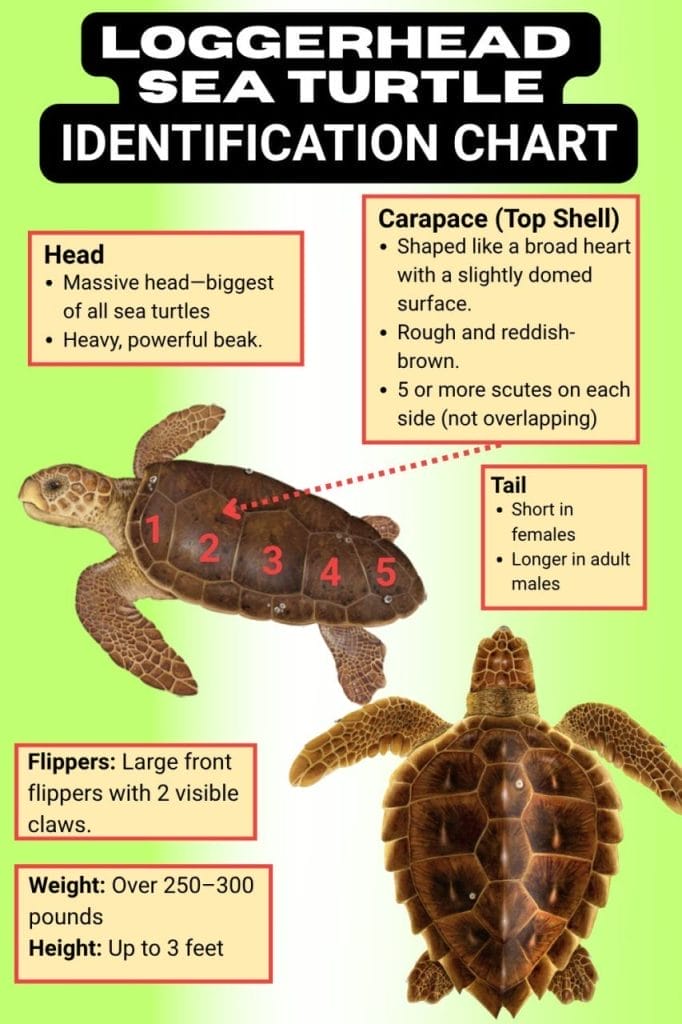
Shell Shape and Color
The shell is thick, a bit heart-shaped like the green, but more rugged. The color leans reddish-brown or dark orange, sometimes with a faded look.
Head and Beak
This is the giveaway. The head is huge—way bigger in proportion than other sea turtles. Their beak is strong and powerful, built to crush crabs and shellfish.
Scutes
Like the green, they also have 5 or more costal scutes on each side. But still no overlaps. It looks more armored, less sleek.
Size
Not as big as the green, but still bulky. Around 3 feet long and about 250 pounds on average. Just a dense, solid turtle.
Habitat
They’re all over the world but prefer coastal areas with sandy bottoms. Common along the U.S. east coast, Japan, the Mediterranean—anywhere with shellfish to munch on.
Snuggle a Plush. Track a Turtle.
🧸 + 🌊 = 🐢 A toy that connects you to real sea turtles in the wild.
Meet Your Turtle
Scan the tag to meet your real sea turtle. Learn its name, species, and see a real photo!
Follow the Journey
Watch your turtle swim across the ocean using the 3D tracking map. It’s like a sea adventure in your pocket.
Support Wildlife
Every plush supports turtle conservation efforts through the Sea Turtle Conservancy.
Click Here & Use Coupon Code: THETURTLEHUB20 For A 20% Discount! (Your hug helps a turtle.)
3. Leatherback Sea Turtle Identification
Now this one’s in a league of its own. No scutes. No hard shell. Just a giant, rubbery beast that looks like it came straight from the dinosaur era.
If you ever spot one, you’ll know. But just in case—here’s what to look for.

Shell Shape and Texture
No bony shell here. It’s soft, leathery, and shaped like a long teardrop with seven ridges running from front to back. Almost looks like a racing turtle—if that were a thing.
Color’s usually dark gray to black, with tiny white or pale spots scattered across the back.
Head and Beak
The head is long and narrow with no scales, just smooth skin. Their mouth is… creepy. It’s built to eat jellyfish, so it’s got backward-pointing spines inside. You won’t see that unless you’re a jellyfish (RIP).
Scutes
None. Zilch. Instead of hard plates, it’s got a rubbery surface with those seven ridges I mentioned. That’s the easiest way to spot it.
Size
Absolutely massive. They can reach over 6 feet long and weigh up to 2,000 pounds. Largest sea turtle in the world—no contest.
Habitat
They like deep, open ocean. You won’t find them chilling near the shore like greens. They roam all over the world, from the tropics to near-freezing waters. Basically, they go wherever the jellyfish buffet is.
4. Hawksbill Sea Turtle Identification
This one’s the diva of the turtle world. Flashy shell, sharp beak, kind of small, but full of attitude. If a sea turtle could post selfies, it would be the hawksbill.
Here’s how to spot one without guessing.
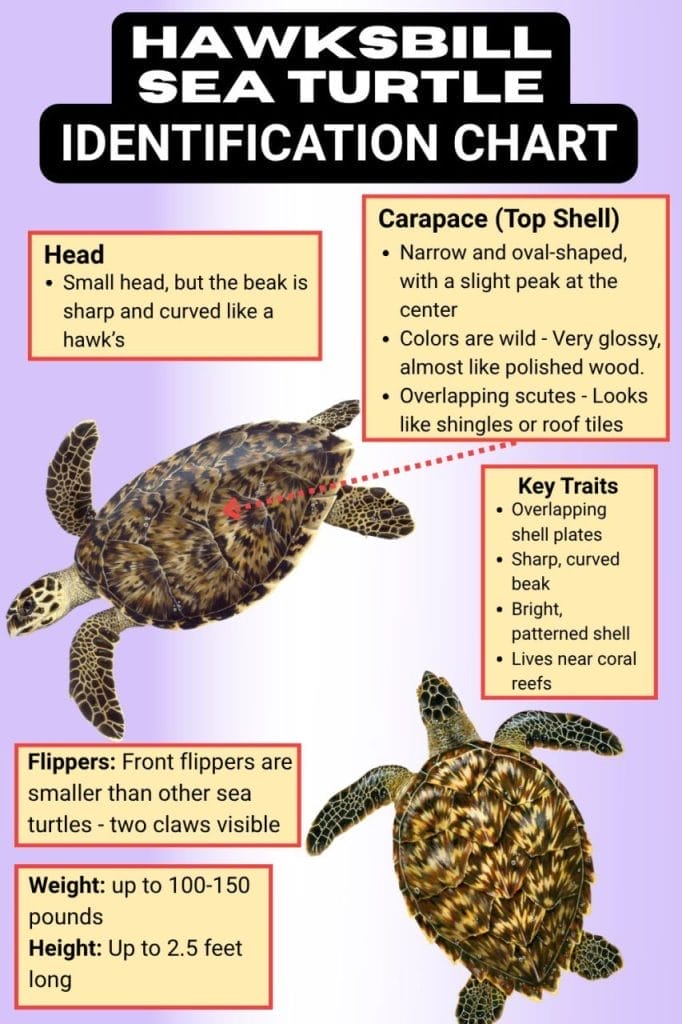
Shell Shape and Color
The shell is narrow, almost oval-shaped, and seriously beautiful. We’re talking amber, brown, gold, even hints of orange—all swirled like marble.
That pretty shell is also why these turtles got hunted hard in the past. It’s called “tortoiseshell” and people used it for jewelry. Not cool.
Head and Beak
Tiny head, but the beak? Sharp and curved like a hawk’s. That’s where the name comes from. It’s made for reaching into coral to grab sponges.
Scutes
This is key. The scutes overlap like roof shingles. No other sea turtle has that. If you see overlapping plates, it’s a hawksbill.
Size
Smaller than most others. Around 2.5 feet long and 100 to 150 pounds tops. More compact but still powerful.
Habitat
They love coral reefs and rocky coastal areas in tropical regions. Common in the Caribbean, Southeast Asia, and parts of the Indian Ocean.
5. Olive Ridley Sea Turtle Identification
This one’s the most common sea turtle—but also the easiest to overlook. Small, simple, and not flashy like the hawksbill. But don’t sleep on it. These guys travel in massive groups when nesting, which is wild to see.
Here’s how to tell if you’re looking at an Olive Ridley.
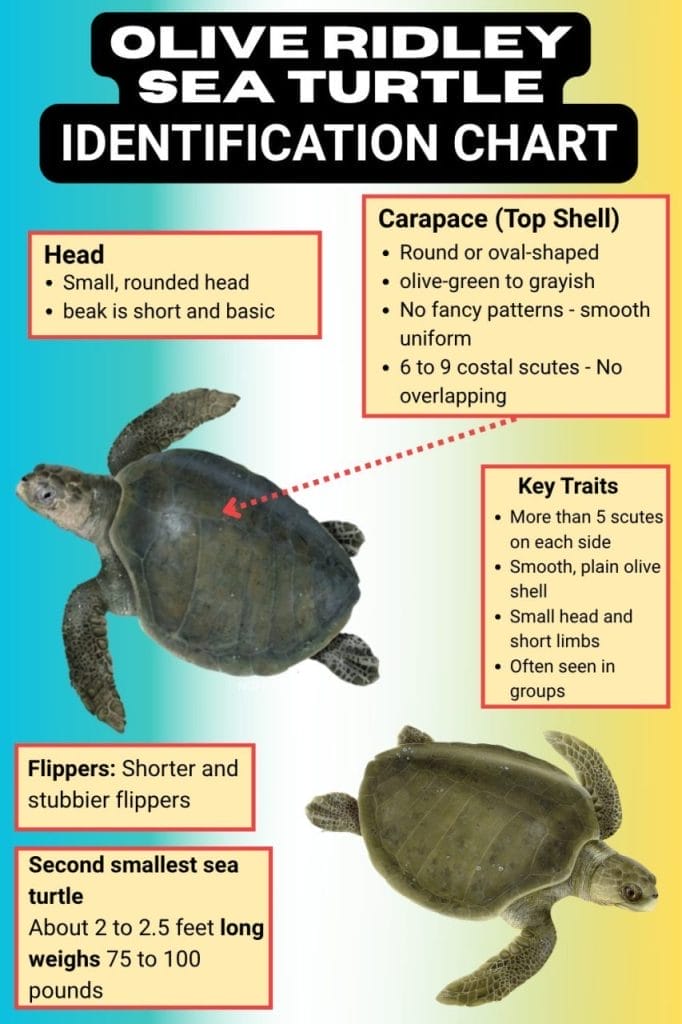
Shell Shape and Color
The shell is rounder than most sea turtles—almost circular. Color stays true to the name: olive-green to grayish, sometimes with a dull sheen.
It’s not showy, but it gets the job done.
Head and Beak
Head is small and rounded. Nothing extreme. The beak isn’t too sharp either—just a basic setup for an omnivore diet.
Scutes
They usually have 6 to 9 costal scutes on each side, which is more than the others. That’s a big clue. And no overlaps here—just neatly lined up.
Size
They’re the smallest of the bunch. Around 2 to 2.5 feet long, and weigh about 75 to 100 pounds. Easy to spot just by size if you’re comparing.
Habitat
Found in warm oceans all over the world. Most famous for their mass nesting events—called arribadas—on beaches in India, Costa Rica, and Mexico. Thousands of them come ashore at once. It’s chaos, but turtle-style.
6. Kemp’s Ridley Sea Turtle Identification
If sea turtles had a secret club, Kemp’s Ridley would be the elusive member nobody sees. Small, rare, and endangered—it’s like the sea turtle version of a limited edition.
Here’s how to recognize it if you’re lucky enough to see one.
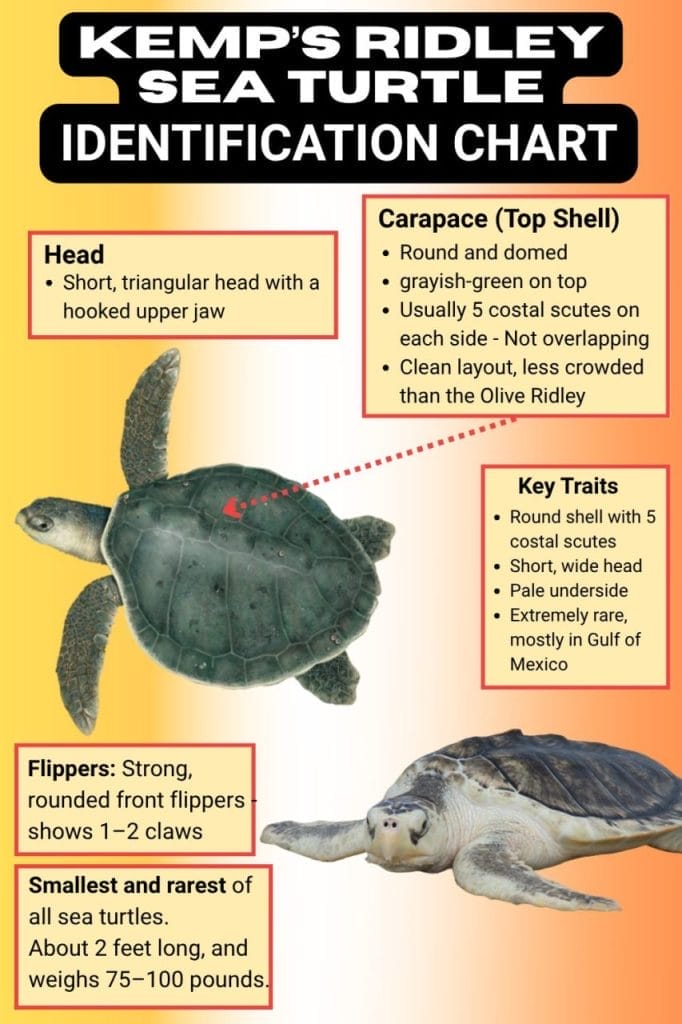
Shell Shape and Color
The shell is round and domed—kind of like the Olive Ridley but flatter on top. Color is grayish-green on the back and pale yellow or white underneath. Nothing flashy, just low-key.
Head and Beak
Head is short and triangular, but a bit bulkier than the Olive Ridley. The beak has a slight hook but not as sharp as the hawksbill.
Scutes
Usually 5 costal scutes on each side. No overlapping. Clean and simple layout. If you’re comparing it with an Olive Ridley, the number of scutes and head shape help.
Size
Smallest sea turtle on the list. Around 2 feet long and up to 100 pounds max. If it looks like a compact sea turtle, there’s a good chance it’s this one.
Habitat
Mostly found in the Gulf of Mexico and occasionally along the U.S. east coast. Like the Olive Ridley, they also do arribadas—but on a much smaller scale, usually in Mexico’s Tamaulipas region.
7. Flatback Sea Turtle Identification
You won’t see this one unless you’re in Australia. It’s the homebody of the sea turtle family—sticks close to shore and doesn’t bother with long migrations.
But if you’re down under, here’s how to know you’ve found a Flatback.

Shell Shape and Color
The name says it all—the shell is flat. It’s broad, low, and has a soft edge, almost like it got pressed down. Color is pale gray, greenish, or sometimes even yellowish. The underside is cream to light yellow.
Head and Beak
The head is medium-sized and smooth. Nothing exaggerated. The beak is short and rounded—nothing aggressive or hooked.
Scutes
Flatbacks usually have 4 scutes on each side, like the green turtle. But the scutes are thin and don’t rise much above the shell’s surface. The edge of the shell also flares out slightly.
Size
Medium to large, but not heavy. Around 3.5 feet long and 200–250 pounds. So, flat but wide.
Habitat
Only found around northern Australia. Nowhere else. They prefer shallow coastal waters, bays, and reefs. No deep-sea roaming for this one.
Sea Turtle Identification FAQs
How can you tell sea turtles apart?
The easiest way to identify sea turtles is by checking three features: shell shape, number of scutes (shell segments), and head size. For example, hawksbills have overlapping scutes, leatherbacks have no hard shell, and loggerheads have massive heads.
What is the most common sea turtle?
The olive ridley is the most abundant sea turtle species, followed by the green sea turtle. Both are found in warm oceans worldwide and are frequently spotted near coastlines.
How many types of sea turtles are there?
There are 7 species of sea turtles: green, loggerhead, leatherback, hawksbill, olive ridley, Kemp’s ridley, and flatback. All are found in oceans worldwide except the flatback, which only lives around Australia.
What sea turtle has overlapping scutes?
Only the hawksbill sea turtle has overlapping scutes (shell plates). This feature makes it easy to identify and distinguish from all other sea turtle species.
Which sea turtle has no shell?
The leatherback sea turtle doesn’t have a hard shell. Instead, it has a soft, leathery covering with 7 ridges running lengthwise. It’s the largest sea turtle species, reaching over 6 feet long.
How do you identify a green sea turtle?
Green sea turtles have 4 costal scutes per side (non-overlapping), a small rounded head, blunt beak, and a heart-shaped shell that’s usually olive or brown. They’re named for their green body fat, not their shell color.
For more fascinating details, see our sea turtle facts article.

About Author
Muntaseer Rahman started keeping pet turtles back in 2013. He also owns the largest Turtle & Tortoise Facebook community in Bangladesh. These days he is mostly active on Facebook.


